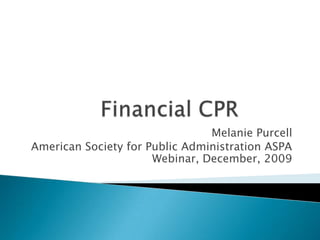
Managing Budget Shortfalls Strategically
- 1. Melanie Purcell American Society for Public Administration ASPA Webinar, December, 2009
- 2. Budget $ Today Time
- 3. Initial reaction when the shortfall is recognized and is relatively manageable or has happened before. Typically, across-the-board cuts are the first step; reflect the timeline and severity of pressure. Single percentage across all departments
- 4. PROS: ◦ Perceived as fair; ◦ Relatively easy to explain intended implementation; ◦ Traditional method and more readily accepted. Typical response to less than 5% total reduction. CONS: ◦ Impact is difficult to explain; ◦ Assumes the organization has “fat” to cut; ◦ Does not reflect organization’s or communities’ goals or priorities; ◦ Short-term strategy with limited depth.
- 5. Percentage or amount cuts that vary according to department or service cut, i.e. public safety reduces by a smaller percentage than parks and recreation. There is recognition that financial conditions are longer-term in nature and/or more severe than originally anticipated.
- 6. PROS: ◦ Introduces strategic response, giving some consideration to goals and priorities; ◦ Relatively easy to describe implementation; ◦ Begins bridging toward larger cuts but still typically less than 10% total reduction. Reasonably readily accepted by public and organizations. CONS: ◦ Difficult to explain impacts; ◦ Typically short-term strategy with limited depth.
- 7. Recognition that financial decline is structural with implications for service levels and quality. Efforts are equally suited to positive financial trends if used in conjunction with strategic planning. Process may engage public, employees, and other stakeholders more intensely.
- 8. PROS: ◦ Reflects priorities and goals of organization and potentially, community; ◦ Easier to explain impacts; ◦ Requires active engagement by stakeholders; ◦ Greater sustainability when conditions change. CONS: ◦ May be difficult or require greater effort to explain implementation; ◦ Strategies take time to develop, communicate, and implement. ◦ May be linked with controversy.
- 9. Define goals and priorities; Determine long-term impact and position; Document long-term logistics and viability of programs; Concentrate on structure especially organizational design; Analyze capacity needs and abilities especially in changing environment.
- 10. Define Goals Design your Organization Develop your Plan
- 11. Build your Budget Measure Results Refine your Goals
- 12. Focus on goals and priorities of organization; Consider current organizational capacity and necessary steps to increase capacity; Define vision for short- and long-term; Concentrate on “how we do business” rather than “how to change the size of how we have always done it”; Define options in terms of revenues and expenditures as well as efficiencies and cuts.
- 13. Revenue Enhancements ◦ Current ◦ Future/ Underutilized ◦ Economic Development of underlying revenue bases Expenditure Reductions ◦ Organization, Communication and Controls ◦ Purchasing, Capital, Insurance ◦ Systems Efficiencies: more and/or better service
- 14. Focus on the basics: Services that are not mandated or not directly related to the health, safety and welfare of citizens need to be reevaluated; it may be time to let the market provide or not provide these services. Ask questions to learn more about every aspect: scope, basis, process…. WHY! It is not just about cuts but about redesigning how we do things.
- 15. Ask questions to learn more about every aspect: scope, basis, process…. Look at little things as well as big ticket items. WHY!!! Communicate goals, plans, and changes from status quo. MANAGE EXPECTATIONS! Think long-term, at least 3 years. Take action now!